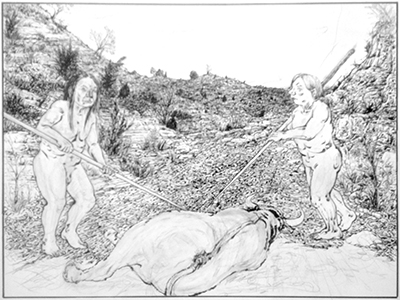| Comic Book Paintings | Glen Holland |
| PROCESS |
STAGES |
PAINTINGS |
| CONCEPT |
PREPARATION | FIRSTLINE (in progress) |
 |
 |
| Firstline 1-1 Translating and modifying from final sketches, penciling in, laying out, composing, rethinking the whole project... |
Firstline 1-2 Light inking with brush and diluted india ink, and inking panel border lines with ink and lettering nib... |
 |
 |
| Firstline 1-3 The first layers of egg tempera are applied over the absorbant gesso. Sometimes I use more ink, stronger outlines around figures and objects portrayed, and sometimes a layer or so of casein paint is applied as an opaque body color, but each painting is treated as a unique creation, and will not necessarily be made the same way as others in the series. The semi-transparent paint doesn't begin to look like something until layers are built up. |
Firstline 1-4 They say that egg tempera painting should be done with a clear plan, well laid out, because it is difficult to make changes, but I sort of work with that-sketches, the modifications and redrafts that take place during penciling and inking-and against it , by just laying on a layer without a clear plan, and letting that determine what happens next... |
 |
 |
| Firstline 1-5 One of the tools of composition is color. A color can be placed around the composition for balance, or to lead the eye, and one way this happens is a color is mixed for one thing and then seems appropriate for another thing and so the already mixed color, perhaps modified, is used to represent something else but still works with the other representational usage visually, abstractly, as an integral part of the compositional ecosystem. |
Firstline 1-6 A few more layers on, and the crosshatching strokes are building up slowly; sometimes, seemingly, nothing is happening, but it is. Still working mainly dark over light, using less strokes over intended light areas, but eventually, to simulate form through blending, light colors will be worked over darker areas, and back and forth. |
 |
 |
| Firstline 1-7 Several sessions later, and the layers are building up more slowly. It is much harder to paint light over dark, the semitransparent paint does not cover well, and the dark impacts the light more than the light impacts the dark. When can adding white paint make a color darker? |
Firstline 1-8 The white paint adds opacity, which helps to obscure the layer below. If the underlying layer is lighter than the paint being applied a little white added to the darker transparent layer makes it seem darker since the underlying light layer is obscured. Many layers have been applied since last update, without a lot of change in appearance. Still a long way to go. |
 |
 |
| Firstline 1-9 Going and going...The fall weather was quite cool and the egg tempera medium lasted more than a day in those conditions...winter will require the use of heat, even overnight, and this may cause a shorter lifespan...but not by much...the egg tempera paint, pigment and medium mixed, doesn't last long, as it begins to "set up". |
Firstline 1-10 After many more days of steady work. The changes are so subtle as to be hardly noticeable in these little images, but it is building up, slowly...so slowly. The overall look, and feel, of the painting has been established and has been incorporated into the decision making process. |
 |
 |
| Firstline 1-11 | Firstline 1-12 |
 |
 |
| Firstline 1-13 | Firstline 1-14 |
a few notes
 |
 |
| For this painting I began with penciling in the figures, as usual, and roughed the complicated background in lightly at first... |
And then went into inking the figures, and then working more on the penciling, and back and forth, as the landscape is being created... |
 |
 |
| so the inking settles the rough ideas left by the pencil drawing and then leads to the next refinements... |
this process is leading to the
potential for this painting to be mainly a black and white ink
drawing/painting, much like the second painting in the My Blue Hawaii
series. |
 |
|
| The inking process takes over and
becomes a thing of it's own, which leads to thinking about how other
panels in this painting will be approached... |
| Index | Comic Book Paintings | Still Life Paintings | News |